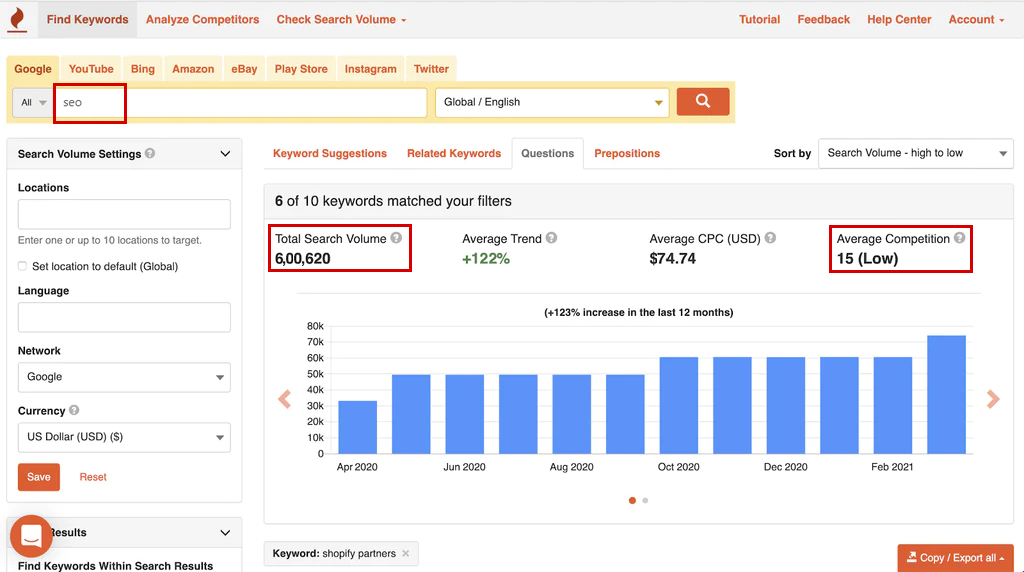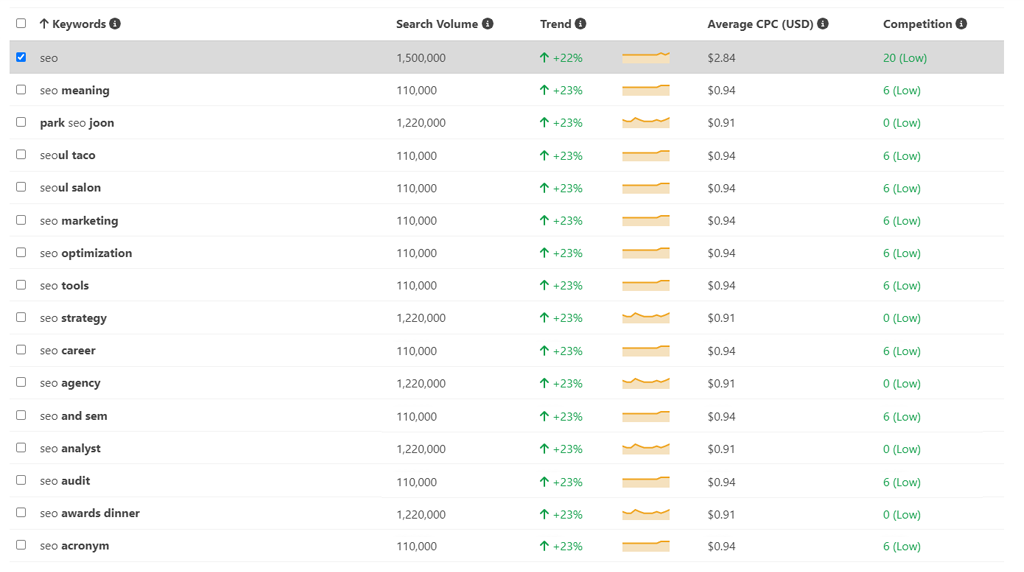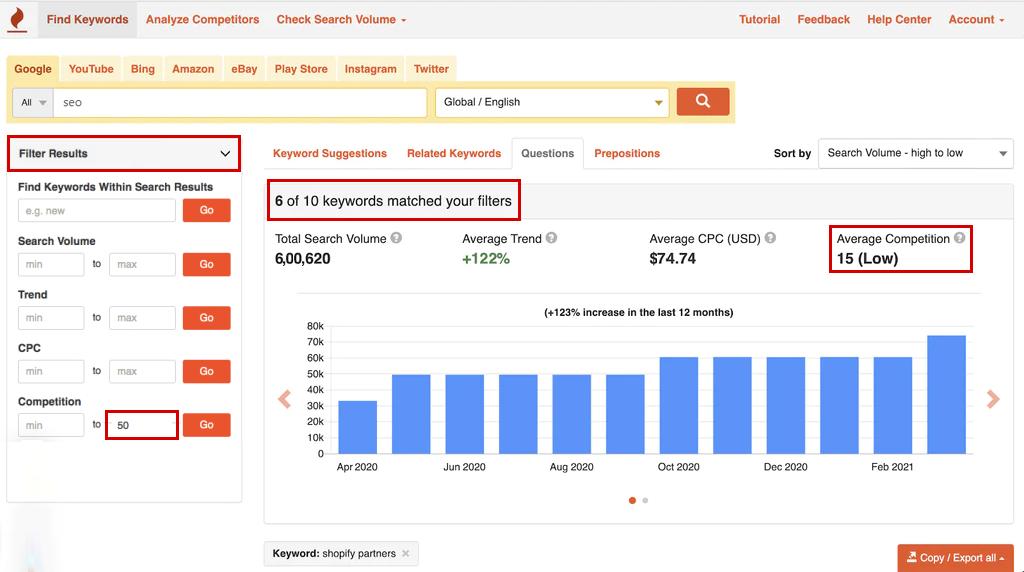There are a lot of things to think about if you want to plan a successful SEO campaign, but the first thing you need to know is that Search Engine Optimization has changed a lot nowadays. There are many moving parts to planning and implementing a successful SEO campaign, including content creation and link building, site audits, and keyword research. But it’s hard to know where to start because there are so many possibilities to consider and only a limited amount of resources. In this post, we will walk you through a series of steps to plan and manage SEO campaigns that consistently increase organic traffic and sales in any industry or niche.
What is an SEO Campaign?
An SEO campaign is a set of predetermined steps to improve a website’s rankings in search results for particular keywords. A dedicated SEO campaign has specific, measurable goals, whereas an ongoing SEO process aims to improve a website’s SEO performance as a whole. This is the difference between a dedicated SEO campaign and an ongoing SEO process. An SEO campaign should be approached like a project with a plan, tasks, milestones, and KPIs for best results. Most of the time, it is a data-driven project with many different parts like researching competitors and keywords, analyzing traffic, creating content, auditing websites, building links, local SEO, and tracking rank. A well-executed SEO campaign can help businesses of any size, in any niche, or in any industry, fix technical issues and improve their content to get higher rankings in search engine results pages (SERPs) and, ultimately, more targeted traffic.
The first step in an SEO campaign is to identify the ideal keywords or subject areas to target with your content and establish specific, measurable objectives. The creation of the content, its SEO optimization, and its publication are the subsequent steps once you have this information at hand. You need to set aside the time necessary to promote your new content both internally and externally after hitting the publish button. Once you complete this step, you can proceed with confidence to launch a new SEO campaign with different keywords and topics in mind. However, you should check on how well your campaigns are doing each month. To ensure that search engines receive the appropriate signals, you may need to adjust your page title and content or pay more attention to off-site links depending on the results.
Hiring an SEO services company can be crucial for running successful SEO campaigns because professional SEO experts have the necessary knowledge, tools, and experience to help businesses optimize their website and content effectively. By outsourcing SEO to experts, businesses can save time and resources while achieving better results in the long run. However if you have time and resources, you can do it yourself as well. Here are the steps for the same:
Steps to Execute a Successful SEO Campaign
Set Key Performance Indicators (KPIs)
What people do once they reach your website is the best type of KPI to measure. You can determine whether visitors to your website enjoy your content and whether they do so by monitoring user behavior. Sessions, users, landing pages, clicks, impressions, and engagement levels will all help you interpret this. You will have a better understanding of what all of this means if you use a tracking tool like Google Analytics or Google Search Console. You can use Google Tag Manager to create more difficult goals to track. You can also make a dashboard for your information to be displayed using Google Data Studio.
Links should always be taken into account as a crucial KPI. Currently, backlinks are one of the most important ranking factors. If you acquire low-quality links, not only will you not be able to increase your website’s authority but it will also hurt your rankings. It is essential to keep track of quality score in order to guarantee that you are creating a high-quality link profile. CTR is another important ranking signal for search engines. For instance, even high rankings won’t help you get more visitors if your search snippets don’t look good enough. If your CTR is low, it will tell search engines that your site doesn’t live up to what users expect, which could hurt your rankings.
Optimize Keyword Placement
In order to create successful search engine marketing campaigns, keyword strategies are absolutely necessary. The selection of high-performing keywords that bring relevant traffic to your business should be part of your keyword strategy. Choosing the right keywords for your SEO campaign can have a significant impact on how well your website ranks on Google and other search engine platforms. The most effective keyword strategies rely on highly relevant keywords, which are those that are closely related to your company or associated with your sector.
Also, Read: How the keywords should be placed within the content?
Choose Keywords With High Search Volume & Low Competition

The notion that keywords are straightforward is inaccurate. Keywords that receive a significant number of searches are usually highly competitive, making it difficult to achieve a high ranking compared to well-established brands and websites that have been ranking for those keywords for an extended period. Conversely, long-tail keywords have lower competition but also lower search volumes.

Choosing keywords with high search volume and low competition is a crucial step in search engine optimization (SEO). These keywords can help increase website traffic and improve the website’s ranking in search engine results pages (SERPs).

By targeting keywords that have high search volume but low competition, businesses can attract more visitors to their website while facing less competition from other websites. Conducting thorough keyword research and analysis can help identify these high-potential keywords, allowing businesses to optimize their content and improve their online visibility.
Also Read: Most popular keywords on Google of 2024
Use Long-Tail Keywords
Long-tail keywords are keyword phrases that are longer and more specific, and visitors are more likely to use them when they are near a point of sale or when they use voice search. The majority of searches for long-tail keywords are less common than for short keywords. They may appear counterintuitive at first, but if used properly, they can be extremely beneficial. Competition for rankings can be fierce with shorter keywords, but visits can be scattered and ROI can be low. If you use long-tail keywords strategically, you may only get a smaller amount of traffic, but your return on investment will be much higher. Your target audience will be precisely the ones you’re looking for, and they’ll be much closer to the point of sale than your less experienced rivals.
Long-tail keywords are useful for businesses that want their content to appear in organic Google searches, but advertisers running paid search marketing campaigns may find them even more useful.
Use Targeted Keywords
SEO not only isolates common search terms to get to the heart of what visitors and Google are looking for, but it also drives more traffic than organic social media, which accounts for over half of all online traffic. Therefore, if keywords are at the center of SEO, you should also place them at the center of everything you do. It is not enough to simply scatter them everywhere. The research of keywords is the first step. To determine broad search intent and your main keywords, make use of SEO tools like Google Keyword Planner, Ahrefs, and even straightforward on-site search bars. Then, investigate further to discover additional long-tail keywords, investigate rivals to discover keyword gaps, and don’t forget to include them in your link anchor text and metadata. Last but not least, avoid keyword stuffing. So as not to interfere with the readability of your content, incorporate them naturally.
Update Content Periodically
Last but not least, keep in mind that when it comes to your SEO campaign, there is no actual finish line. There is always work to be done and you can still improve on what you have already done because of constant updates from search engines and competition from other businesses. Going back and updating content with keywords, backlinks, and improved readability is a great way to get started if you haven’t been using SEO properly yet. By regularly updating the pages, you can even guarantee that those that have been performing better will continue to see growth in traffic or improve upon it.
Returning to your keyword research, this is an excellent opportunity to use these phrases and competitor analysis to create a long-term SEO campaign. There should be a lot of different keywords that branch off from each other, which gives you more content ideas. Make one article on a particular subject, an article that serves as a foundation for several others that are more specific. Tools like SEMrush and Yoast can be used to conduct a thorough content audit. Adding and updating old content can double your traffic, just make sure to use the internal and external linking and try to make it as consistent as possible.
Examine Your Site and Do an SEO Audit
The principal check to make prior to launching a search engine optimization campaign is to analyze your site. This is a one-time action you must take to ensure that your website does not have any major issues that could hinder the effectiveness of your SEO campaigns. For instance, since mobile-friendliness is a significant ranking factor, it is highly likely that your campaigns will fail if your website is not mobile-friendly. In general, you should check the following before beginning an SEO campaign.
- Mobile-friendliness of your site
- Loads quickly on desktop and mobile devices
- Supports SSL
The next step is to conduct an SEO audit to examine your website’s SEO healthiness. If you have just finished an SEO audit, you don’t have to do it every time you start a new SEO campaign. However, if you haven’t yet, this is a very important step to take. You must examine your technical SEO infrastructure as part of the audit, particularly the following items:
- Check how your canonical URLs are defined
- Optimize text SEO settings to avoid indexing errors
- Optimize XML sitemap
- A good website structure is hierarchical
Set Your Campaign’s Objectives
An SEO campaign’s specific goals and objectives set it apart from a standard ongoing SEO process. This indicates that you should clearly define your objectives prior to beginning a campaign. Valid use cases include:
- to make yourself more visible on Google for keywords for which you do not yet have a presence
- to rise to the top of rankings for particular SEO keywords
For instance, if you have a very specific objective in mind: to get high rankings on Google for the term “SEO Campaign.” To accomplish this objective, you have to do the following:
Create a comprehensive guide on “How to build an SEO Campaign”.
When the post is published it is linked to older posts so that search engines can easily find this new post.
Promote your posts via social media such as Facebook, Instagram, and Twitter.
Create new posts about running an SEO campaign and include a link to this one.
As can be seen, the steps are precise from beginning to end. This helps you keep your attention on what you need to do for this task. Typically, your overall SEO action plan should include each SEO campaign you run. The action plan depends on your SEO strategy and can incorporate at least one SEO campaign.
Build Topic Relevance
The last step of your SEO campaign is to conclude whether you really want to publish more content connected with a similar subject to begin building what is called topic relevance. The hypothesis behind topic relevance is:
- Although Google ranks pages individually, it does take into account the content of the website on which they are published
- Sites that are thought of as legitimate for a specific topic are probably going to rank better for topic related keywords
You will need to publish more related content rather than just a single post if your objective is to achieve rankings for a topic in which you do not yet have a presence. You can begin by publishing a post with the most relevant topic keywords in mind, and then add more content over time. In the new post, ensure that you connect to your more seasoned post utilizing anchor text that incorporates the pages you need to rank for.
Remove Zombie Pages
Zombie pages are the pages that create next to zero traffic and influence the site’s search rankings. While doing site review, advertisers ought to distinguish and erase their zombie pages. Eliminating these non-traffic producing pages can assist organizations with decreasing skip rates, further develop conversion rate and have higher click through rates. By removing zombie pages, businesses can boost site rankings in addition to improving the user experience. On-page SEO can be improved by improving the website’s E-A-T (Expertise, Authority, and Trustworthiness) and producing high-quality content optimized for headlines, descriptions, HTML tags, and images.
Marketers should optimize website URLs, fix broken links, and monitor SEO results. A zombie page is one that has a negative impact on your site’s SERP ranking and receives little to no traffic. The presence of zombie pages lowers a website’s overall ranking and decreases the number of clicks it receives because Google ranks your website as a whole.
The following are the benefits of removing zombie pages from your website:
It enhances the user experience. Websites with fewer zombie pages have higher rates of click-through and conversion. Additionally, it lowers your website’s bounce rate.
It raises your Google ranking. Google ranks your entire website. Subsequently, removing zombie pages from your site further develops your overall site ranking and makes it more simple for web crawlers to crawl through pages on your site.
Optimize for Rankbrain
A component of Google’s algorithm known as RankBrain makes use of machine learning and artificial intelligence to better comprehend the purpose of a search query. This knowledge may assist in providing users with the most relevant search results. It was introduced into the core algorithm in 2015 and was at first simply applied to the 15% of previously unheard of questions it got. Google included it in every search query once they gained more confidence in it. Optimizing directly for RankBrain is not possible.
Yet, what you can improve is to optimize your content, which will develop how RankBrain sees your site. The top-ranked websites that most closely match a user’s query are the primary focus of RankBrain. So your responsibility is to ensure you make content that can match those particular requirements. The following are a few different ways you can more readily optimize your content for RankBrain.
Use Natural Language
When writing content, you should write in a manner that is similar to how you would speak.
When you write your content, read it aloud to yourself. Does it sound like something someone would say? Is it in a conversational manner? RankBrain may have an easier time comprehending your content if you write in this style.
Find Search Intent
Review the top-ranked pages after entering the keyword you want to rank for in the search results. Based on how people interact with the results, Google knows that these pages are the kind of content that people are looking for.
Optimize for Relevance
When you are sure about the intent of the keyword, you should make content and upgrade it to match that aim. Make each page as comprehensive as you can by treating it more like a “topic” than just a keyword.
Enhance CTR (click-through rate)
Because RankBrain looks at how many clicks you get from search results, it’s important to write great title tags and meta descriptions. One of the best ways to get more clicks is to use emotions in the title. Your title can also stand out from the rest by making use of numbers, brackets, or parentheses. Take a look at the most popular pages and the most popular paid ads in your niche as sources of inspiration.
Prefer Quality over Quantity
Writing a post around a single keyword is no longer necessary. In the past you might have composed a different post for the expressions “get more deals”, “increment your deals”, or “increase your monthly income” so you could optimize for every one of these keywords.
Sadly, that no longer works with RankBrain. RankBrain should be able to recognize that the term “get more deals” is related to those other terms by creating a single post with as much content as possible.
Build Internal and External Links
Use internal linking to promote your content after you publish a post. Locate related pages on your website and include internal links to the new post. Match the keywords you want to rank for with the anchor text of your internal links. For instance, after we publish this post, we will link to it from other pages on our website that contain the phrase “SEO campaign.”
Experience has shown that many webmasters neglect this step, which is a major SEO error. By linking internally to older posts, you assist search engines to find your new pages and they likewise get a portion of the PageRank which helps new content rank quicker.
Externally promote your content. This is called link building, and it’s the process of getting backlinks from other websites. Great quality backlinks go about as ‘votes of trust’ and this assists the page with positioning higher in the search results. The best way to promote your content is not to send unwelcome emails to hundreds of webmasters asking for links. Instead, you should make thoughtful references to other websites in your content and compile a list of people who would love to promote it. Keep in mind that in addition to building links, you can promote your content through paid Facebook campaigns, newsletters, and informing your influencer list.
Build Backlinks
The process of obtaining authoritative inbound links to your website is known as link building or creating backlinks. When building backlinks, you need to take into account a number of factors, including how relevant the topic of the linking site is to yours, how recently the link was created, how the anchor text is used on that site, how many other links on the site in total link back to yours, and more. It’s a good idea to have this process in your social media and content creation strategies because obtaining organic backlinks can be difficult. A great way to get organic backlinks is to write blog posts that people read and cite, as well as social media posts that are widely shared. Let us look at some of the ways to build backlinks:
- Finding and correcting broken backlinks: You can report a broken link to the site’s webmaster and request another link to your site as a replacement.
- Posts on guest blogs: You can increase traffic to your website by blogging on other websites, which helps you build backlinks and builds your reputation.
- Making infographics: Infographics’ straightforward visual hierarchy is a favorite way for people to consume information. A good way to get backlinks is to create infographics that people share and include embed codes with them.
- Content promotion: Get your best content out there. Search for sites that do week after week or month to month roundups of related content, and present yours. Don’t forget to send an email to subscribers who are interested in your content if you have a database of them.
Monitor Results
The lessons you gain from one SEO campaign can be applied to future campaigns. Thus, observing the results of each campaign means quite a bit to future achievement. A portion of the significant measurements, or quantifiable measures, to incorporate are:
Natural traffic: This tells you how many people find your website through organic search. Assuming you’re picking the right keywords and making great content with them, the number of visitors to the site should increase.
Bounce rate: This is the number of people who visit your page and then leave without interacting with it. If your bounce rate is high, your content is not meeting visitor expectations.
Clickthrough Rate (CTR): This measures how many people click on a search result to get to your website. Assuming that 3 individuals in 10 ticks go to your site thus, that is a 30% CTR. On a search engine results page (SERP), the CTR demonstrates how well you are catching people’s attention.
Keyword rankings: How the keywords in your site rank against the keywords in other high ranking websites.
Site authority: The backlink profile of your website can help Google determine its authority.
Page loading speed: It’s essential to know this in light of the fact that slow loading pages will make clients jump to other fast loading sites.
New backlinks and referring domains: The quantity of new backlinks you get from various domains is a significant measure of how your site is performing.
Ranking Factors for SEO
Accessible and Secure Site
Obviously, the first of our SEO ranking elements has to do with having the right sort of URL. Specifically, that is a URL that is simple for Google’s bots to access and crawl. To put it another way, Google needs to be able to visit the URL and examine the content of the page to comprehend what it is about. You need the following to assist the bots:
- A well-coded website built with a website builder
- a robots.txt file which tells Google where it can and cannot look for information about your site
- a sitemap that lists all of your pages
Mobile-friendliness
Mobile-friendliness is yet another significant SEO ranking factor. A greater number of individuals utilize cell phones than desktops to get to the web, and that is one explanation there’ve been changes in how Google positions search results. Google’s mobile-first index is now an important factor, which means the search engine prioritizes mobile-optimized websites over desktop-oriented ones when ranking results. You run the risk of being ranked in the wrong place if your website is not optimized for mobile devices.
Explore Google AMP (accelerated mobile pages) if you have the team, time, and motivation. The positive aspect is that mobile devices load your pages almost immediately. Additionally, it has been speculated that Google ranks AMP-built websites higher than other websites. The disadvantage is that you must create an additional version of your website in accordance with AMP’s guidelines. Then, you have to keep up with everything. As you can imagine, this project can take a lot of time.
Optimized Content
Duplicate content is a negative SEO ranking factor to be aware of. Fresh, original content is always best for SEO. Additionally, if you have similar content, use canonical URLs to indicate to Google which one should be ranked as the most authoritative. However, one of the most frequently asked questions is, how to optimize content with LSI keywords. SEO focuses on more than just the primary keyword. It’s also critical to include terms related to the most common search terms. LSI (latent semantic indexing) keywords are the name given to these. In order to assist Google in selecting which results to display, they offer a kind of online word association.
It’s important to note that content optimization includes optimizing for questions and natural language searches as more people use voice search. Because people typically speak differently than they type, this means that some LSI keywords will be longer. Consider this: Assume you run a restaurant. Let’s say, half of your customers type “best restaurant near me”. However, people also use voice searches to find “the best restaurant in Barcelona”.
Google’s answer might look different, despite the fact that both questions are asking about the same thing. One way to ensure that your restaurant ranks for both sets of questions is to use LSI keywords. The greater your ability to assist Google in comprehending your content, the more likely it is that you will rank in your niche.
Technical SEO
Optimizing content for better search engine rankings includes fixing the code and technical glitches. Particularly if you’re more of a wordsmith than a “techie,” this can be intimidating. Even if you don’t know how to code, here are some things you can control:
- Create SEO friendly URLs
- Optimize XML sitemap
- Use schema markup to let Google know what sort of content your website produces
- Avoid indexing errors
Also, Read: Technical SEO Issues: Common Reasons Why Your Website is Not Ranking on SERPs
Domain, URL, and Authority
The best course for picking your domain? Center around a URL that mirrors your business and optimize it accordingly. Authority is an important factor in search engine ranking factors. That typically comes from a combination of excellent content and off-page SEO signals like social shares and inbound links. Additionally, it can include the author’s authority, thanks to E-A-T. This has been standardized by Moz into page authority and domain authority scores, which range from 0 to 100 and indicate the likelihood of a page or domain appearing in search results.
To Conclude
Running targeted SEO campaigns is one of the best ways to maximize SEO’s return. You will be able to get better results by breaking down your overall SEO objectives into smaller tasks and running an SEO campaign for each. An SEO audit is highly recommended before beginning a campaign to examine your website’s setup and overall SEO health. Your SEO campaigns’ performance can be negatively impacted by any critical setup or technical SEO issues. Once you have fixed these issues, you can continue monitoring your SEO campaign and do changes as needed.
FAQs
Can SEO campaigns be devised only at the start of a business?
It is better if you have an SEO campaign while starting your business, even if you have missed it, you can devise one right now and rectify the SEO issues in your business.
Can I plan my own SEO campaign?
Yes, you can plan it on your own with the help of our above post. In case of expert assistance you can contact a digital marketing company to help you.
What is the use of long-tail keywords?
If you are a starter, long-tail keywords will help you rank better since the short ones will already be ranking for the authority websites in your niche.


























